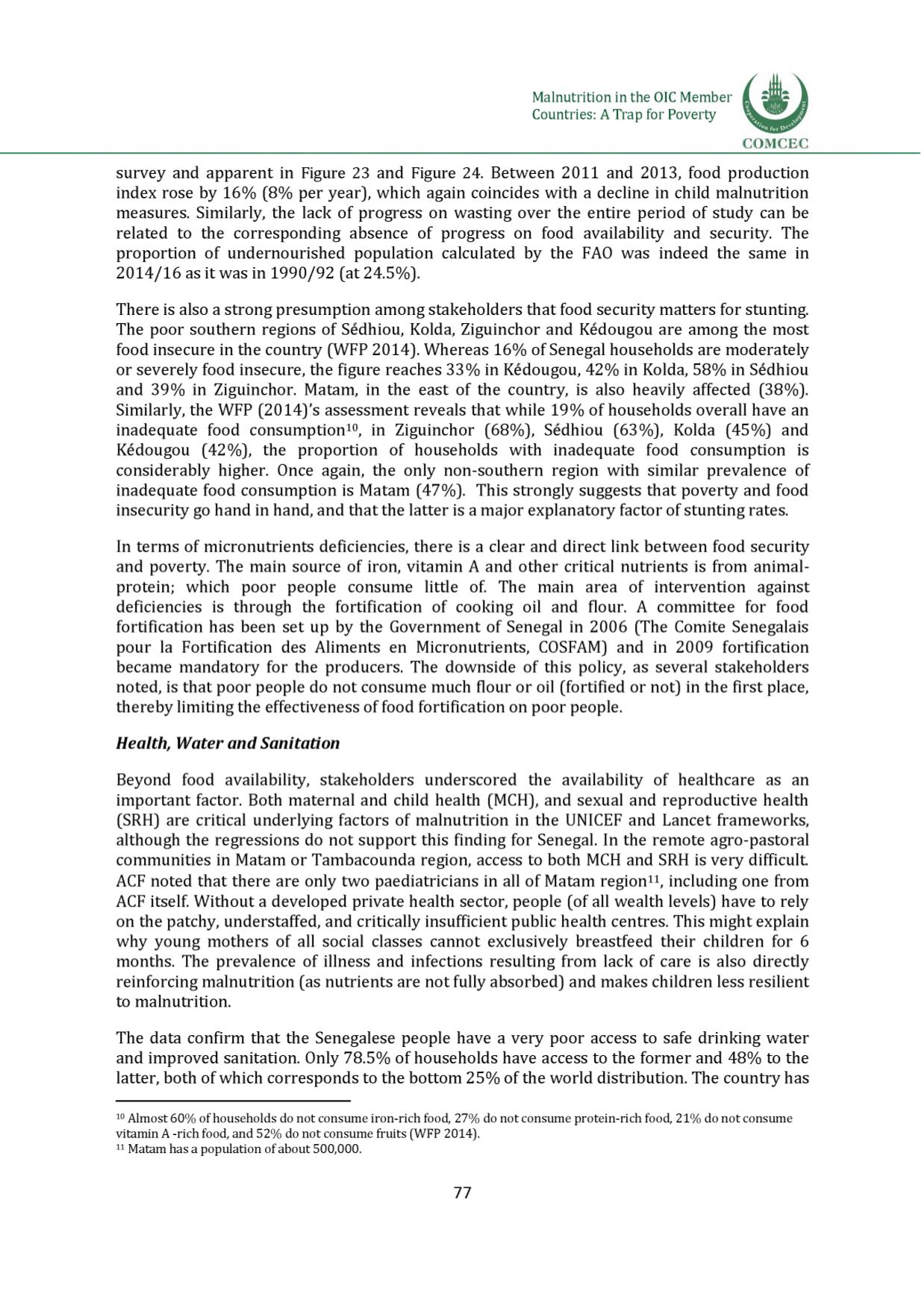

Malnutrition in the OIC Member
Countries: A Trap for Poverty
survey and apparent i
n Figure 23 an
d Figure 24. Between 2011 and 2013, food production
index rose by 16% (
8
% per year], which again coincides with a decline in child malnutrition
measures. Similarly, the lack of progress on wasting over the entire period of study can be
related to the corresponding absence of progress on food availability and security. The
proportion of undernourished population calculated by the FAO was indeed the same in
2014/16 as it was in 1990/92 (at 24.5%].
There is also a strong presumption among stakeholders that food security matters for stunting.
The poor southern regions of Sedhiou, Kolda, Ziguinchor and Kedougou are among the most
food insecure in the country (WFP 2014]. Whereas 16% of Senegal households are moderately
or severely food insecure, the figure reaches 33% in Kedougou, 42% in Kolda, 58% in Sedhiou
and 39% in Ziguinchor. Matam, in the east of the country, is also heavily affected (38%).
Similarly, the WFP (2014)'s assessment reveals that while 19% of households overall have an
inadequate food consumption10, in Ziguinchor (
6 8
%), Sedhiou (63%), Kolda (45%) and
Kedougou (42%), the proportion of households with inadequate food consumption is
considerably higher. Once again, the only non-southern region with similar prevalence of
inadequate food consumption is Matam (47%). This strongly suggests that poverty and food
insecurity go hand in hand, and that the latter is a major explanatory factor of stunting rates.
In terms of micronutrients deficiencies, there is a clear and direct link between food security
and poverty. The main source of iron, vitamin A and other critical nutrients is from animal
protein; which poor people consume little of. The main area of intervention against
deficiencies is through the fortification of cooking oil and flour. A committee for food
fortification has been set up by the Government of Senegal in 2006 (The Comite Senegalais
pour la Fortification des Aliments en Micronutrients, COSFAM] and in 2009 fortification
became mandatory for the producers. The downside of this policy, as several stakeholders
noted, is that poor people do not consume much flour or oil (fortified or not] in the first place,
thereby limiting the effectiveness of food fortification on poor people.
Health, Water and Sanitation
Beyond food availability, stakeholders underscored the availability of healthcare as an
important factor. Both maternal and child health (MCH), and sexual and reproductive health
(SRH) are critical underlying factors of malnutrition in the UNICEF and Lancet frameworks,
although the regressions do not support this finding for Senegal. In the remote agro-pastoral
communities in Matam or Tambacounda region, access to both MCH and SRH is very difficult.
ACF noted that there are only two paediatricians in all of Matam region11, including one from
ACF itself. Without a developed private health sector, people (of all wealth levels] have to rely
on the patchy, understaffed, and critically insufficient public health centres. This might explain
why young mothers of all social classes cannot exclusively breastfeed their children for
6
months. The prevalence of illness and infections resulting from lack of care is also directly
reinforcing malnutrition (as nutrients are not fully absorbed] and makes children less resilient
to malnutrition.
The data confirm that the Senegalese people have a very poor access to safe drinking water
and improved sanitation. Only 78.5% of households have access to the former and 48% to the
latter, both of which corresponds to the bottom 25% of the world distribution. The country has
10Almost 60% of households do not consume iron-rich food, 27% do not consume protein-rich food, 21% do not consume
vitamin A -rich food, and 52% do not consume fruits (WFP 2014].
11Matam has a population of about 500,000.
77
















